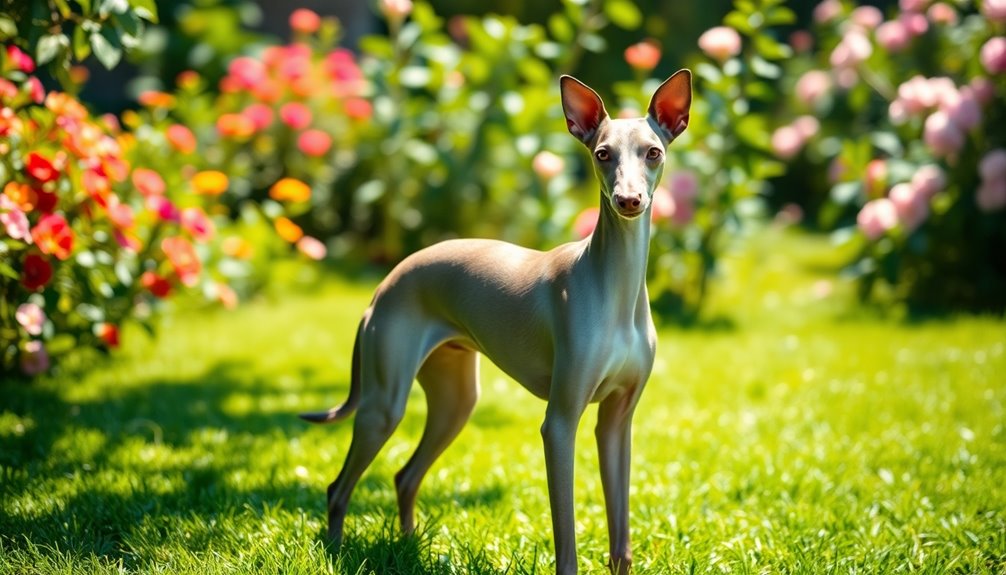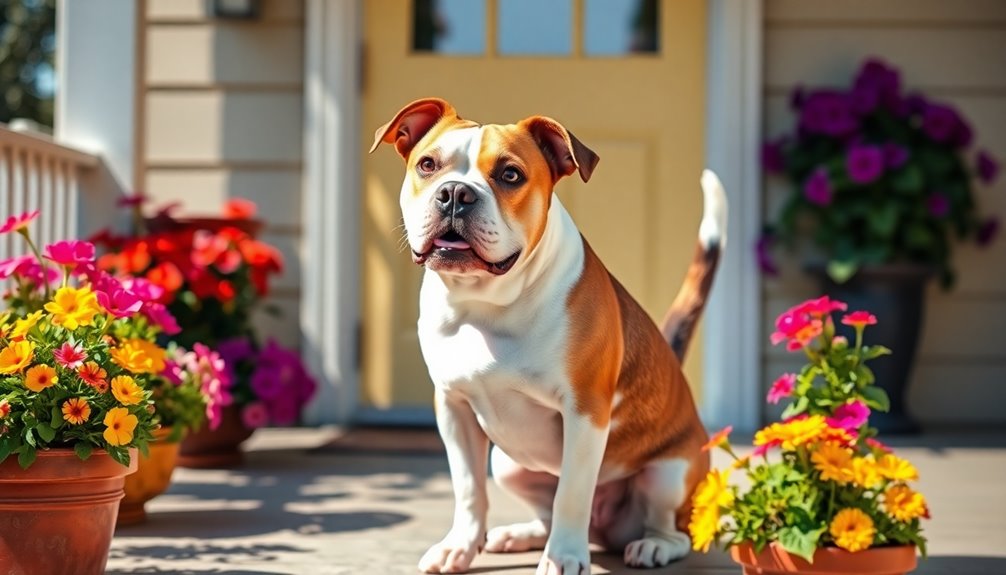Schnoodles are a delightful mix of Poodle and Schnauzer, known for their intelligence and playful nature. These adorable dogs make fantastic family pets, thanks to their affectionate personalities and protective instincts. They come in various sizes and have hypoallergenic, low-shedding coats, which could be perfect if you have allergies. Regular grooming is a must to keep their coats healthy. Schnoodles thrive on interaction and require daily exercise to stay fit and happy. Whether you're a first-time pet owner or an active individual, these dogs are an excellent choice. Discover what else makes Schnoodles such special companions!
Key Takeaways
- Schnoodles are a crossbreed of Poodles and Miniature Schnauzers, known for their intelligence and affectionate nature.
- They come in various sizes, ranging from 5 to 70 pounds, with hypoallergenic, low-shedding coats.
- Regular grooming is essential to maintain their curly or wavy coats and prevent matting.
- Schnoodles require daily exercise and thrive on interaction, making them excellent companions for active families.
- Their cheerful temperament and adaptability make them ideal pets for first-time owners and urban living.
Introduction
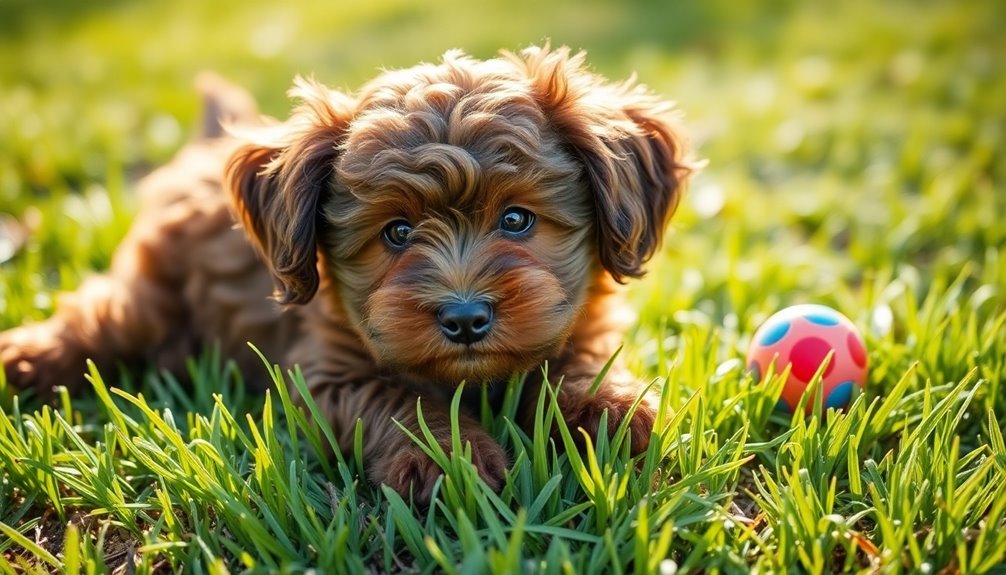
Introducing the Schnoodle, a delightful blend of Poodle and Schnauzer, you'll find an intelligent and energetic companion that brings joy to any household.
These dogs are known for their loving and level-headed nature, making them excellent family pets. You'll appreciate how quickly they pick up cues and learn tricks, showcasing their high intelligence.
Schnoodles come in various sizes, reflecting their parent breeds. You might encounter Miniature and Standard Schnoodles, while Giant and Toy variations also exist.
This size diversity allows you to choose a Schnoodle that perfectly fits your living space and lifestyle. Additionally, their lifespan of 12-15 years means you can enjoy many years of companionship with your furry friend.
When it comes to grooming, Schnoodles require a bit of dedication. Their coats can be wiry, curly, or a mix of both, and they need regular brushing to prevent knots and mats.
You'll want to schedule professional grooming every 4-6 weeks to keep their fur looking its best. Additionally, don't forget about regular nail trimming and dental care to maintain overall health.
With their various coat colors and textures, including black, gray, and cream, Schnoodles not only charm with their personalities but also with their stunning appearances.
History and Origin
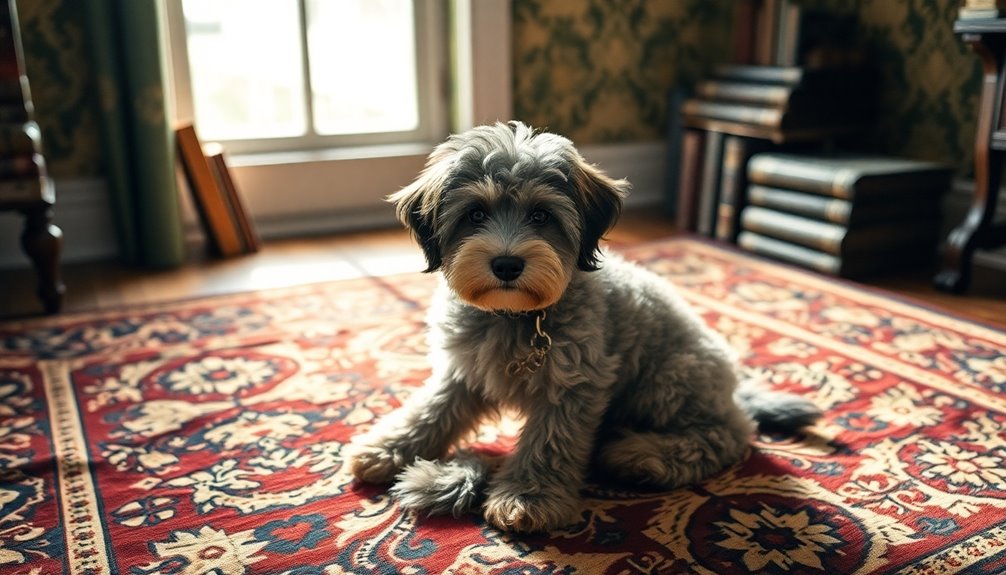
The Schnoodle originated in the 1980s, during a time when Poodle mixes became popular among dog enthusiasts. Breeders aimed to create a loving companion that combined the Schnauzer's sturdy build with the Poodle's intelligence, making them ideal family pets. As this breed developed, it captured the hearts of many, thanks to its charming personality and hypoallergenic traits. Today, Schnoodles are recognized for their highly intelligent nature and are often eager to please their owners.
Where and when the breed originated
If you're curious about the origins of the Schnoodle, you'll find that this charming breed emerged in the 1980s in the United States. It was created in response to a rising demand for small, low-maintenance companion dogs. The Schnoodle is a cross between the Schnauzer and Poodle breeds, aimed at combining the best traits of both.
During this time, Poodle hybrids gained popularity, and breeders focused on creating hypoallergenic or low-dander dogs. Initially, they crossed Miniature Schnauzers with Toy or Miniature Poodles, but over time, they began incorporating Standard Poodles with Giant and Medium Schnauzers. This focus on creating intelligent and sociable pets has made the Schnoodle a favorite among families.
Notably, there's no specific city or region tied to the breed's origin, making it a product of collaborative breeding efforts across the country.
While the Schnauzer has its roots in 14th-century Germany as a farm dog, the Poodle was originally bred in Germany for water retrieving. This diverse lineage contributes to the Schnoodle's unique characteristics, including variations in size, color, and coat texture.
However, since the breed lacks official recognition by major Kennel Clubs, it remains a delightful blend of both parent breeds without a strict standard.
Companion and Family Pet
With their cheerful temperament and affectionate nature, Schnoodles have quickly become popular as companion and family pets. These adorable mixes thrive on playtime and family activities, showcasing their devotion and loyalty to you and your loved ones. Their high affection levels make them perfect companions, while their protective instincts can keep your family safe.
Schnoodles are great for households with children of all ages, as both parent breeds—Schnauzers and Poodles—are known for being child-friendly. Early socialization is key, as they may be wary of new people. However, once well socialized, they generally warm up to strangers and other animals.
You'll find that Schnoodles can form special bonds with one family member while remaining friendly with everyone else. They do need daily physical activity and mental stimulation to thrive, and they adapt well to various living situations. Due to their high energy levels, they benefit from engaging activities and toys for enrichment.
A bit of grooming is necessary due to their low-shedding but dense fur. If you're looking for a loving, loyal family pet, a Schnoodle could be the perfect match for your home.
Physical Characteristics
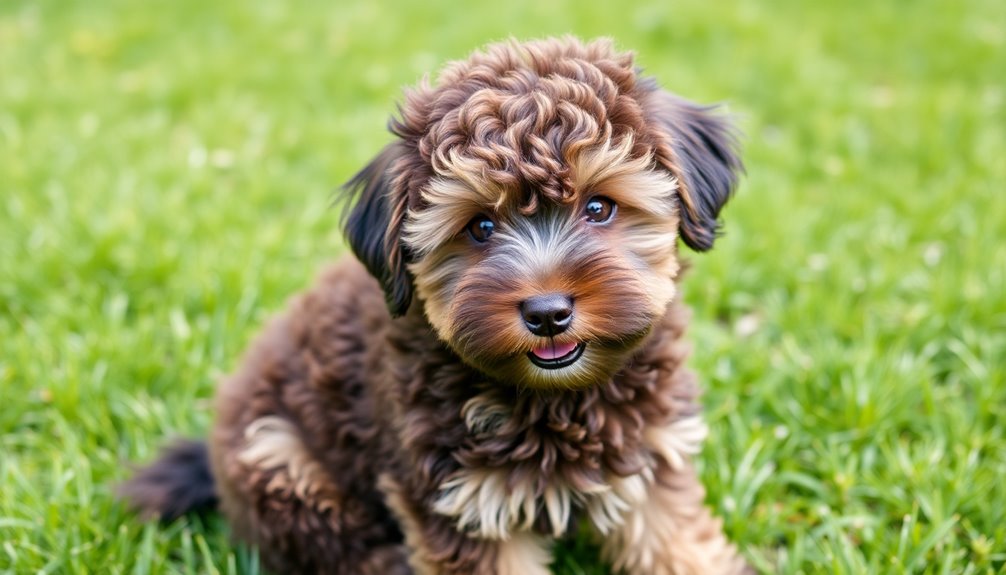
When you think about Schnoodles, size and coat texture are key characteristics that stand out.
These adorable pups can range from 5 to 70 pounds, depending on their lineage, and they boast a curly, hypoallergenic coat that makes them a great choice for allergy sufferers.
With their low-shedding fur, they not only look cute but also fit well into various living situations. Additionally, their size ranges from 12-25 pounds on average, influenced by parent backgrounds and genetics, making them a versatile option for different households.
Size, weight, and coat details
The Schnoodle, a delightful mix of Poodle and Schnauzer, showcases a range of sizes and weights that cater to various preferences. You can find Toy Schnoodles standing 10–12 inches tall and weighing between 5-15 pounds, perfect for those who want a tiny companion.
If you prefer something slightly larger, the Miniature Schnoodle measures 12–16 inches tall and weighs 15-30 pounds.
For those seeking a more robust dog, the Standard Schnoodle is 16–20 inches tall and weighs 30-50 pounds.
Finally, the Giant Schnoodle stands impressively at 20–26 inches and can weigh anywhere from 50-110 pounds.
These dogs have a compact and athletic build, ensuring a balanced and proportionate body regardless of size. Most Schnoodles reach their adult size between 12 and 18 months, with smaller varieties maturing earlier than their larger counterparts. Additionally, their coat type is hypoallergenic and low-shedding, making them suitable for families with allergies.
Lifespan varies as well—smaller Schnoodles often live longer, typically between 10 and 16 years.
With such a range of sizes and weights, you're sure to find a Schnoodle that fits perfectly into your lifestyle.
Curly, Hypoallergenic Coat Texture
Schnoodles boast a curly, hypoallergenic coat that adds to their charm and appeal. This unique coat can range from wavy to tightly curled, offering a variety of textures. Some Schnoodles inherit the soft, luxurious coat of a Poodle, while others may have a wiry texture reminiscent of a Schnauzer. Regardless of the texture, these curly coats can be medium-length and dense, creating a delightful appearance.
One of the most attractive features of Schnoodles is their low-shedding nature, thanks to their Poodle lineage. Although they're not completely hypoallergenic, they shed very little, which helps reduce the spread of dander, a common allergen. Their curly coats also trap dander more effectively, making them a better choice for allergy sufferers. Additionally, Schnoodles can weigh anywhere from 10 lbs to 80 lbs, which can influence the amount of grooming needed based on size.
To keep their coats looking their best, you'll need to commit to regular grooming. Brushing at least twice a week—or daily for curly coats—helps prevent matting and tangling. Additionally, professional grooming for trimming and baths can keep your Schnoodle's coat healthy and vibrant.
With a variety of colors and patterns available, your Schnoodle's coat will surely turn heads wherever you go!
Temperament and Personality

When you think of a Schnoodle, picture a playful and intelligent companion that thrives on interaction. These dogs aren't only great for families but also adapt well to individuals and other pets with the right socialization. Their cheerful demeanor makes them a joy to have around, bringing energy and affection to any household. Early training and leadership are crucial for well-adjusted behavior, especially during the puppy toddler period. Additionally, positive reinforcement techniques can enhance their learning experience and strengthen the bond between the dog and owner.
Playful and Intelligent Demeanor
With their playful spirit and keen intelligence, Schnoodles make delightful companions for active families. These energetic dogs thrive on physical activities like jogging, fetch, and agility, often showcasing their excitement with the adorable "Schnoodle 500," where they run in circles with their hind end tucked up. Additionally, their playful nature can sometimes lead to trilling behaviors, which are often a sign of happiness and affection.
They love car rides, especially when they're heading to visit familiar faces, and they'll even use their front paws to hold toys and blankets, adding a silly charm to their playful nature.
Schnoodles aren't just fun-loving; they're also highly intelligent thanks to their Poodle heritage. This makes them quick learners and eager to please, which is essential for effective training. Positive reinforcement, like treats and praise, works wonders with them.
Early training is crucial to curb any stubbornness inherited from their Schnauzer side. In addition, their small size makes them ideal for travel and bringing along on family outings.
Their affectionate demeanor allows them to form strong bonds with their families, and they thrive on social interaction. Whether it's cuddling or playtime, Schnoodles love being the center of attention, making them a joy to have around.
This combination of playfulness and intelligence truly sets them apart.
Suitability for families, individuals, or other pets
Finding the right pet for your family or lifestyle can be a rewarding experience, and a Schnoodle's adaptability makes it an excellent choice. They fit well in various living situations, whether you're in an apartment or a larger home.
Schnoodles form strong bonds with family members, often favoring one person, and they thrive on human interaction. When socialized early, they're great with kids but require supervision during playtime to prevent any mishaps. Additionally, their high energy levels require significant mental and physical stimulation, ensuring they remain happy and engaged.
For individuals, Schnoodles are perfect companions, needing regular mental and physical stimulation to stay happy. They don't do well with long periods of solitude, so if you're often home, they'll thrive. Their affectionate nature makes them ideal for singles or seniors, as they provide loyal companionship.
If you have other pets, early socialization is crucial to ensure peaceful coexistence. Schnoodles can be territorial but are generally friendly with well-socialized strangers.
Their watchdog traits might make them vocal, but they usually remain quiet. Consistent training and positive reinforcement help curb any stubbornness, ensuring your Schnoodle becomes a well-rounded family member.
Health and Lifespan
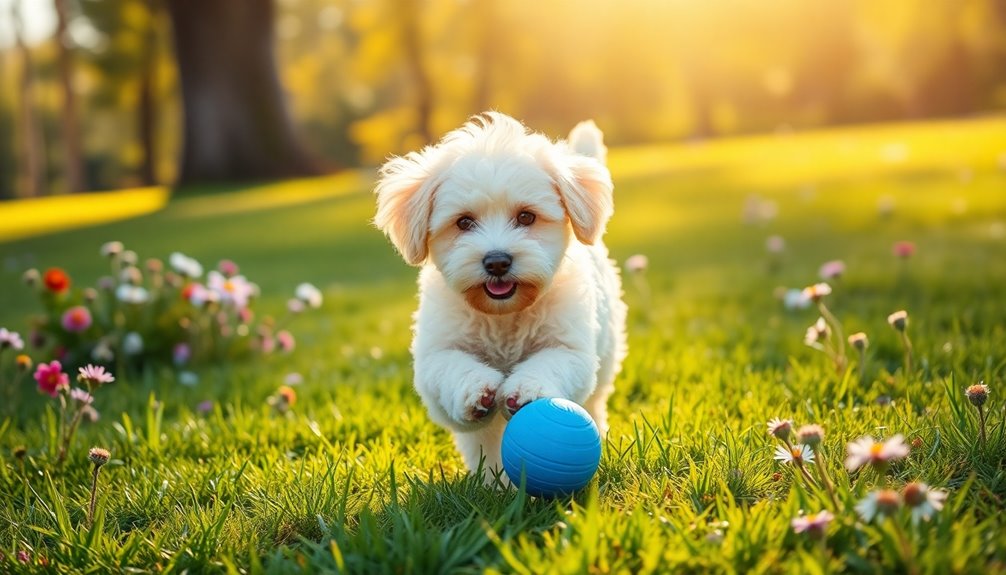
When it comes to your Schnoodle's health and lifespan, understanding common concerns can make a big difference. You'll want to be aware of genetic predispositions, like hip dysplasia and cataracts, that could affect your pup. Regular veterinary check-ups are important for early detection of health issues.
Typical lifespan of the breed
Schnoodles, the lovable mix of Schnauzers and Poodles, typically enjoy a lifespan ranging from 12 to 16 years.
However, this lifespan can vary based on the size of your Schnoodle. If you have a smaller Schnoodle, like a Toy or Miniature, you might find they live a bit longer—around 12 to 18 years—while Standard and Giant Schnoodles tend to have shorter lifespans of 10 to 16 years and 10 to 15 years, respectively.
Interestingly, female Schnoodles often have a slight edge in lifespan compared to their male counterparts.
Factors such as diet, exercise, and genetics play a significant role in determining how long your furry friend will be by your side. Additionally, responsible breeding practices that include genetic testing can help ensure your Schnoodle inherits fewer health issues.
One of the advantages of owning a Schnoodle is the hybrid vigor that comes from their mixed breed heritage.
This diversity generally results in a healthier dog and can help extend their lifespan compared to purebreds.
To maximize your Schnoodle's lifespan, ensure they receive regular veterinary care, a balanced diet, and plenty of mental stimulation and exercise.
This way, you can enjoy many happy years together.
Common health concerns or genetic predispositions
Health is a crucial aspect of owning a Schnoodle, as they can inherit various genetic predispositions from their parent breeds. You should be aware of several common health concerns that may affect your furry friend.
Addison's disease, for instance, can lead to symptoms like inappetence, vomiting, and diarrhea due to adrenal gland issues. Cataracts and diabetes mellitus are also prevalent, with diabetes causing excessive thirst and urination.
Moreover, neurological issues like epilepsy can manifest as seizures, while progressive retinal atrophy might lead to blindness by around five years of age. Orthopedic problems, such as hip dysplasia and luxating patellas, can create mobility challenges. Schnoodles are a mix of two breeds, which may contribute to their diverse range of health issues.
You may also encounter other conditions, including hairy ear canals that increase the risk of ear infections, urinary stones, and pancreatitis. Gastric dilatation-volvulus (bloat) is particularly dangerous and requires immediate veterinary attention.
To ensure your Schnoodle's health, consider genetic health risk tests and choose responsible breeders who prioritize health. This can help you avoid potential complications and ensure a happy life for your beloved pet.
Tips for maintaining health and wellness
Maintaining your Schnoodle's health and wellness involves a combination of proper diet, exercise, and mental stimulation. Start by feeding a well-balanced diet that's approved by the Association of American Feed Control Officials (AAFCO). Choose food formulated for your Schnoodle's life stage—puppy, adult, or senior—and ensure it includes a balanced mix of protein, carbohydrates, and healthy fats. Consulting with your veterinarian can provide tailored dietary recommendations.
Incorporate daily walks, play sessions, and interactive games to keep your Schnoodle fit and active. Adjust the exercise routine based on their size and age, considering their high energy levels. Regular physical activity not only prevents weight gain but also promotes overall well-being. Schnoodles, being a mix of Schnauzer and Poodle, thrive on a varied exercise routine that caters to their playful nature.
Mental stimulation is equally important. Use puzzle toys, engage in training sessions, and teach new tricks to keep their minds sharp. Providing interactive games can prevent boredom and destructive behaviors.
Finally, don't forget regular veterinary checkups to ensure your Schnoodle stays healthy. Keep vaccinations up to date, socialize them from a young age, and schedule grooming appointments every 4-6 weeks to maintain their coat and hygiene.
Care Requirements
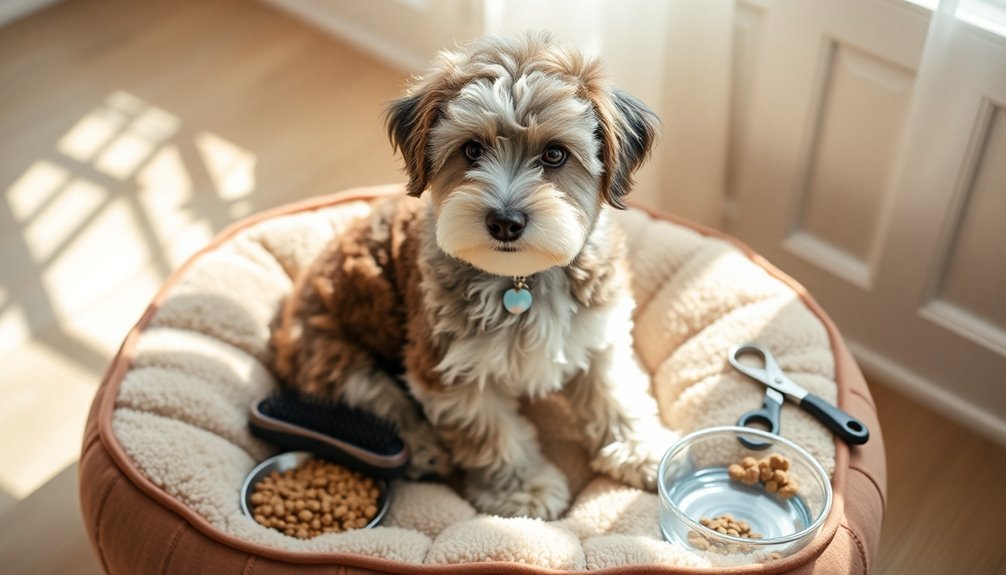
When caring for your Schnoodle, you'll need to focus on grooming, exercise, and nutrition. Regular trimming helps keep their coat healthy and manageable, while daily exercise keeps them mentally and physically stimulated. Feeding your Schnoodle a balanced diet tailored to their life stage is essential for their overall well-being, and it's important to remember that grooming their unique coat is a crucial aspect of their care. Additionally, providing them with high-quality protein sources in their diet can support their overall health and energy levels.
Regular Trimming Required
To keep your Schnoodle looking its best, regular trimming is essential. You should schedule professional grooming every 4-6 weeks to maintain their coat and keep it healthy. This includes trimming around the face, paws, and ears, with clippers for the back and sides and scissors for more delicate areas.
At home, brush your Schnoodle's coat 2-3 times a week to prevent matting and tangling. If their coat is particularly curly or long, near-daily brushing is ideal. Always brush before bathing to remove knots and clumps, making the process easier on your pup. After bathing, brush again to keep their coat smooth and healthy. Establishing a routine for grooming helps reduce anxiety for your Schnoodle during sessions.
In addition to coat care, don't forget other grooming tasks. Trim their nails every 3-4 weeks to avoid discomfort, clean their ears weekly with a vet-approved cleaner, and brush their teeth 2-3 times a week.
Bathe your Schnoodle every 4-6 weeks with mild dog shampoo, adjusting based on their needs. Starting grooming early helps your Schnoodle get used to the process, ensuring a comfortable experience for both of you.
Exercise requirements and energy levels
Schnoodles need at least 30-60 minutes of exercise each day to stay healthy and happy. Daily walks are essential for keeping them fit and preventing health problems. You can mix it up with walking, running, or jogging, depending on your activity level. Regular physical activity helps burn off their high energy levels, so don't skip those exercise sessions.
Without enough physical activity, your Schnoodle might develop destructive behaviors or health issues.
Various exercise options keep things interesting. Walking is a basic yet effective way to engage them. You can enhance their energy release by playing fetch or tug of war, which they love. Agility training with household items or special kits can be both fun and stimulating. Engaging in interactive games provides mental stimulation and helps strengthen the bond between you and your Schnoodle.
Mental stimulation is just as important as physical exercise. Use puzzle toys and interactive games to keep their minds engaged. Training sessions and learning new tricks can challenge their intelligence, while early socialization is crucial for a well-adjusted personality.
Always consider environmental factors, as Schnoodles aren't fond of extreme weather. Ensure you provide a safe, secure area for outdoor play, allowing them to thrive in family settings.
Feeding tips and diet recommendations
Maintaining your Schnoodle's health goes beyond just exercise; a well-balanced diet plays a significant role too. Start by ensuring your pup gets plenty of protein from lean meats like chicken, turkey, or beef, which are essential for muscle health.
Include balanced fats, such as omega-3 and omega-6 fatty acids, for energy and coat health. Complex carbohydrates like sweet potatoes, brown rice, and quinoa provide sustained energy and aid digestion.
When choosing food, always opt for high-quality ingredients with real meat as the first component, avoiding fillers like corn, wheat, and soy. Consider grain-free options if your Schnoodle has sensitivities, as some dogs may benefit from a grain-free diet which can help with specific dietary needs.
It's crucial to maintain a balanced calcium to phosphorus ratio, especially for puppies, to prevent potential health issues. Hybrid status can lead to varied health concerns, so being aware of potential risks can guide your dietary choices.
Pay attention to any dietary adjustments needed for specific health concerns, such as joint problems or food allergies. Regularly assess your dog's weight and avoid overindulging in treats to prevent obesity.
Generally, feed your Schnoodle between 0.5 and 1.25 cups of high-quality kibble daily, adjusting according to their age, size, and activity level. Always consult your vet before making significant dietary changes.
Training and Socialization
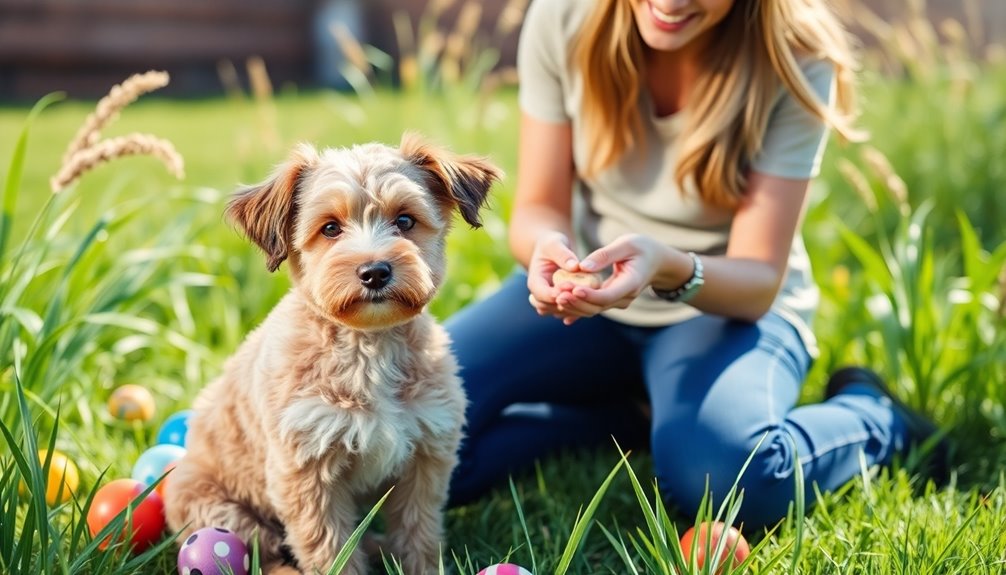
Training and socialization are crucial for your Schnoodle's development.
Their eager-to-please nature makes them receptive to learning, but introducing them gradually to new environments will help build their confidence and reduce the likelihood of separation anxiety. Regular exposure to diverse people, pets, and environments shapes their future behavior, ensuring they become well-adjusted companions as they grow into a socialized dog.
Eager to Please Nature
The eager-to-please nature of Schnoodles makes them a delight to train and socialize. Their intelligence, inherited from both the Poodle and Schnauzer, allows them to pick up cues quickly and learn various tricks. Early training is essential to establish good habits and harness their willingness to please.
Use positive reinforcement techniques—like treats, praise, and playtime—to keep them engaged and motivated during sessions. Remember, short training bursts of 5-10 minutes help maintain their focus and prevent boredom.
Schnoodles thrive on social interaction, needing to be surrounded by people and other pets. Early socialization with children and other dogs is crucial for developing a well-rounded temperament, so teach kids how to interact gently with your Schnoodle. Supervision is necessary to ensure safety during these interactions.
While their eager nature makes them trainable, keep an eye out for potential stubbornness, especially if they're tired. Training in quiet environments helps minimize distractions, allowing them to focus better.
Patience and consistency are vital to overcoming any stubborn moments, ensuring that your Schnoodle grows into a well-behaved companion.
Gradual Exposure to New Environments
Building on their eager-to-please nature, Schnoodles benefit greatly from gradual exposure to new environments. Start this process during their critical socialization period, which runs from 3 to 14 weeks. Introduce your Schnoodle to new people, animals, sounds, and situations to help them become well-rounded and polite. Use positive reinforcement techniques like treats and praise to create positive associations with new experiences.
Enroll your Schnoodle in puppy classes for structured socialization and safe interactions with other dogs. Gradually introduce them to different environments—homes, parks, and public spaces—while keeping sessions short to avoid overwhelming them. Monitor their comfort level and never push them into fearful situations; let them adjust at their own pace. The brain's receptivity peaks during this phase, making it an ideal time for learning.
When it comes to grooming, introduce tools gradually, pairing them with treats and praise to ensure a positive experience. Organize playdates with other dogs and supervise interactions to promote positive behaviors.
Separation Anxiety in Puppies
Separation anxiety can be a challenging issue for Schnoodle puppies, manifesting in various behaviors that signal distress when left alone. You might notice excessive barking or howling, destructive chewing, or even accidents in the house. Signs like pacing, panting, or digging at doors can indicate your puppy's unease. Separation anxiety is one of the most common behavioral disorders in dogs, which underscores the importance of addressing it early.
Several factors contribute to this anxiety, including genetics, early negative experiences, or changes in your family dynamics. If you've transitioned from being home all day to working outside, your puppy may struggle with being alone. Lack of exercise and mental stimulation can exacerbate the issue, too.
To prevent separation anxiety, consider crate training to create a safe space for your puppy. Start by teaching them to be comfortable alone in another room while you're home, gradually increasing the time they spend alone. Use positive reinforcement with treats to associate separation with good experiences.
Make their environment cozy with soft bedding and toys, and leave the radio on to ease silence-induced anxiety. If you're gone for long periods, hiring a dog walker can help keep your Schnoodle content and engaged.
With patience and proper training, you can lessen their anxiety and make them feel secure.
Ideal Living Environment
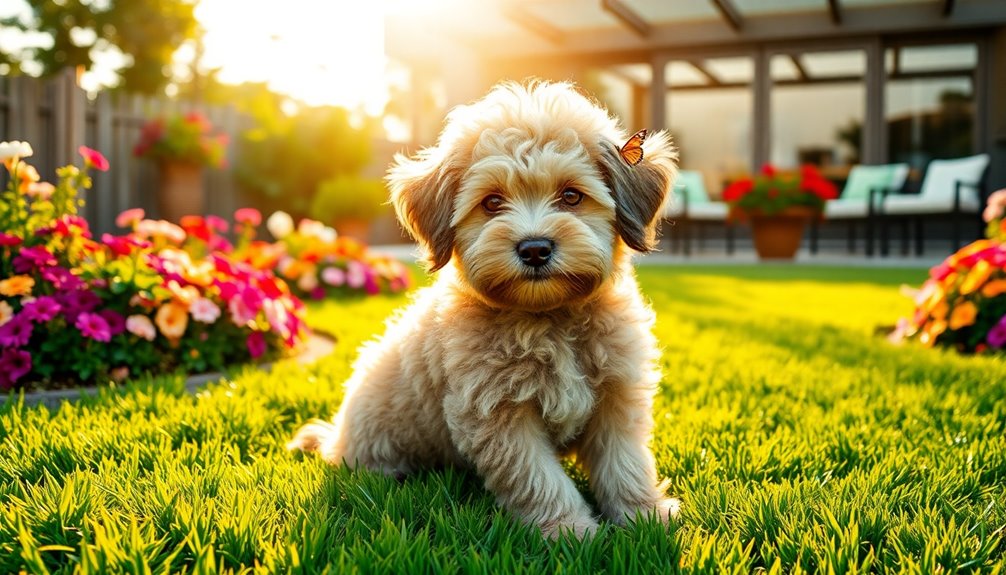
If you live in an urban apartment with a balcony, your smaller Schnoodle can thrive in that environment. Just make sure to provide daily walks and opportunities for play to keep them happy and healthy. They prefer moderate temperatures, so be mindful of the climate when planning outdoor activities. Regular vet check-ups are essential for maintaining their overall health and addressing any potential common health issues.
Urban Apartment With Balcony
Living in an urban apartment with a balcony can be an ideal environment for a Schnoodle, especially given their adaptability and friendly nature.
These small, low-noise dogs fit perfectly in compact living spaces, making them a great choice for city dwellers. Miniature Schnoodles thrive in apartments, needing only regular exercise through walks and playtime, which you can easily manage within your daily routine. To maximize your living space, consider using vertical storage solutions to keep your apartment organized and clutter-free.
A balcony serves as a wonderful outdoor escape, allowing your Schnoodle to enjoy fresh air and sunshine. Just ensure that it's secure to prevent any escapes. Additionally, it's important to provide consistent training to help them adjust to being alone, as this can significantly reduce their risk of developing separation anxiety.
Inside, you'll want to create a dog-proof space where your Schnoodle can feel safe when left alone. The friendly disposition of Schnoodles also helps them socialize well with neighbors and other pets, reducing any potential conflicts in your complex.
Moreover, their low-shedding coats mean less cleaning for you, a significant perk for apartment living.
With consistent training and positive reinforcement, you can curb any stubbornness and barking, ensuring a harmonious living environment. A Schnoodle can truly be a delightful companion in your urban apartment, bringing joy and companionship to your daily life.
Moderate Temperatures Preferred
Schnoodles thrive best in moderate temperatures, making them well-suited for a variety of living environments. While they can adapt to different climates, keeping them in extreme heat or cold isn't ideal for their comfort and health.
If you live in a warmer area, ensure your Schnoodle has access to shade and plenty of ventilation when outdoors. Indoor living is often the best solution, as it helps regulate temperature and keeps your furry friend cozy.
When it comes to living space, larger Schnoodles need a house with a fenced yard to burn off their energy, while smaller ones can thrive in apartments with daily walks and playtime. Additionally, since Schnoodles are known for their high energy levels, regular exercise is essential for their well-being.
Regardless of size, all Schnoodles require regular exercise to prevent boredom and destructive behavior. Make time for daily walks, play sessions, and mental stimulation through training or puzzle toys.
Hypoallergenic With Minimal Shedding

If you're considering a Schnoodle, you'll love the variety of coat colors they come in, from apricot to gray. Their hypoallergenic qualities and minimal shedding make them a popular choice, often seen in viral pet videos showcasing their playful nature. You'll appreciate how their unique coats not only look good but also help keep allergy concerns at bay. Additionally, their curly coat requires regular grooming to maintain its health and appearance.
Variety of Coat Colors Available
Often admired for their striking appearance, Schnoodles come in a stunning variety of coat colors that appeal to many dog lovers.
You'll find common shades like black, gray, and white, which can be solid or part of bi-color patterns. If you prefer something richer, sable offers a dark brown hue with a black mask, while apricot provides lighter options.
Further expanding your choices, you can also consider cream, copper (often referred to as red), champagne, and golden shades that range from light to dark.
For those who enjoy unique patterns, Schnoodles can showcase parti-color combinations, featuring white with patches of another color, or even phantom markings that create a ghostly look.
One of the best aspects of Schnoodles is their hypoallergenic, low-shedding coats. This trait makes them suitable for allergy sufferers, as their curly or wiry coats trap dander more effectively, reducing allergens in your home. Additionally, the curly coat is predominantly found in F1B and F3 generations, which contributes to their unique appearance.
Just remember, regular grooming and occasional trims are essential to keep their coats healthy and looking their best.
With so many options, you're sure to find a Schnoodle that perfectly fits your aesthetic preferences!
Schnoodle in Viral Pet Videos
Viral pet videos featuring Schnoodles have taken the internet by storm, captivating viewers with their adorable antics and charming personalities. Their unique appearance, combining the wiry eyebrows of the Schnauzer and the curly coat of the Poodle, makes them a visual delight.
It's no surprise that these clips often showcase their expressive faces and playful nature, drawing in fans from all over. Schnoodles also shine in interactive play videos, where they demonstrate their intelligence and eagerness to learn new tricks. Regular playtime and positive interactions can further enhance their bond with owners.
Their hypoallergenic, low-shedding coats contribute to their appeal, as they produce less dander, making them suitable for allergy sufferers. However, it's wise to test your reaction before bringing one home.
These dogs are incredibly social, thriving on human interaction and enjoying the company of both children and other pets. Their friendly temperament and playful spirit make them perfect companions, often featured in cute and funny scenarios that highlight their affectionate nature.
Whether they're learning new commands or simply playing around, Schnoodles capture hearts everywhere, proving they're not just adorable but also intelligent and trainable.
Active Lifestyle Compatibility?
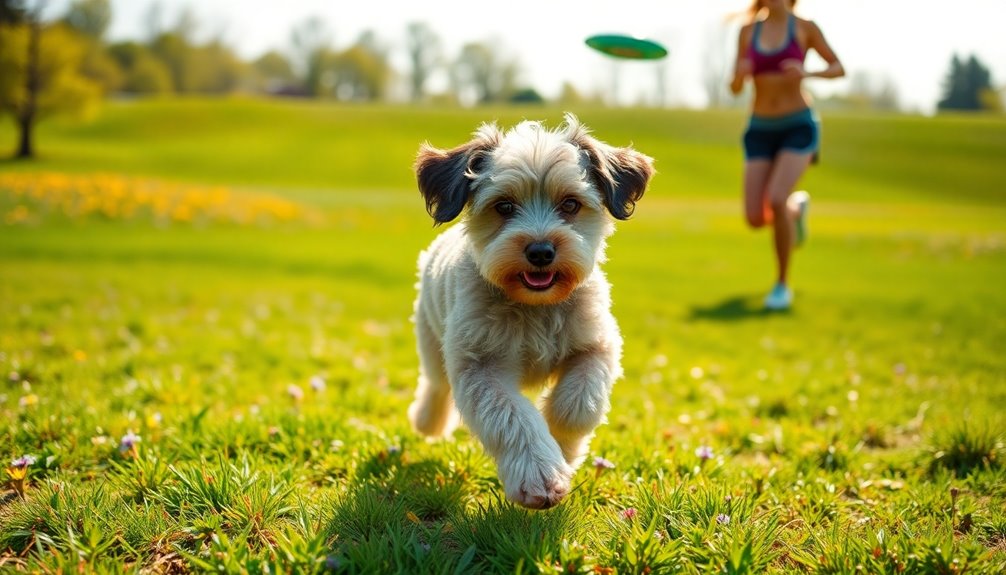
If you're considering a Schnoodle, you'll find they're a great match for an active lifestyle.
Their energetic nature means they thrive on daily exercise and play, making them ideal for first-time owners who enjoy outdoor activities. Schnoodles require about 30-60 minutes of exercise daily to keep them happy and healthy. Plus, keeping up with their grooming needs is manageable, allowing you to focus on fun adventures together.
Ideal for First-Time Owners
For first-time owners seeking a furry companion that fits an active lifestyle, the Schnoodle stands out as an excellent choice.
These dogs boast moderate energy levels, requiring just 30-60 minutes of exercise each day. Whether you enjoy daily walks, playing fetch, or engaging in agility training, your Schnoodle will happily join in on the fun. They thrive on playtime and exploration, making them perfect for those who love outdoor activities. Additionally, their affectionate nature ensures they are always eager to be by your side, enhancing your adventures together. To ensure their well-being, regular dental check-ups are important to prevent health issues.
Training a Schnoodle is a rewarding experience due to their intelligence and eagerness to learn. They respond well to positive reinforcement and can master complex tricks and commands.
Just remember, they can have a stubborn streak, so consistency in training is key. Early socialization helps them adapt and thrive, especially around children and other pets.
As loyal companions, Schnoodles form strong bonds with their families and prefer to be included in daily activities. They don't like long periods of isolation, so be prepared to engage with your furry friend.
With their friendly nature and compatibility with active lifestyles, Schnoodles make ideal pets for first-time owners ready for an adventure.
Grooming Needs and Maintenance
Owning a Schnoodle means embracing not just their playful nature but also their grooming needs. You'll need to brush your Schnoodle 2-3 times a week, or daily if they've a curly coat, to prevent matting. The frequency depends on their coat length and texture, so keep an eye on that. Regular brushing also reduces shedding and keeps the environment cleaner. Additionally, maintaining a regular grooming schedule can help prevent dental issues that are common in many dog breeds.
Bathing every 4-6 weeks with a mild, dog-friendly shampoo will help keep their coat healthy.
Professional grooming every 6-8 weeks is common, especially if you want to maintain a specific style like the puppy cut or teddy bear cut. Groomers can expertly trim and shape their coat, ensuring it looks its best.
In addition to coat care, don't forget regular nail trimming every 2-4 weeks, dental care through brushing or chews, and cleaning their eyes and ears as needed.
While Schnoodles have moderate to high grooming needs, this doesn't hinder their energetic lifestyle. They thrive on daily walks, playtime, and mental stimulation.
With proper grooming and care, you'll have a happy and healthy companion who can adapt well to various living environments.
Frequently Asked Questions
How Much Do Schnoodles Typically Weigh?
Schnoodles typically weigh between 6 and 75 pounds, depending on their size category.
Toy Schnoodles are the smallest, weighing around 6-12 pounds, while Miniature Schnoodles range from 13-30 pounds.
Standard Schnoodles fall between 20-50 pounds, and Giant Schnoodles are the largest, weighing 50-75 pounds.
So, when you think about getting a Schnoodle, consider which size fits best with your lifestyle and living situation.
Each size has its own unique charm!
What Colors Do Schnoodles Come In?
When you're looking at dog breeds, you'll find a variety of coat colors. Common colors include black, gray, white, and apricot.
You might also see cream, copper, or golden shades. Unique patterns like parti-color and merle can add even more charm.
Additionally, combinations such as black and tan or red and white can create striking appearances. Each color and pattern adds to the dog's personality, making them even more lovable.
Are Schnoodles Good With Children?
Yes, they can be great with children! When you socialize them early and supervise interactions, they often form strong bonds with kids.
Their playful and affectionate nature makes them excellent family pets. With consistent training, they learn to behave well around children.
Just remember to educate kids on how to interact gently, ensuring everyone stays safe and happy.
How Long Do Schnoodles Live on Average?
On average, Schnoodles live between 10 to 16 years, but this can vary based on their size.
Miniature Schnoodles often enjoy longer lifespans of 10 to 18 years, while Standard ones typically live 10 to 16 years.
Giant Schnoodles usually have a shorter lifespan, ranging from 10 to 15 years.
Factors like genetics, diet, exercise, and responsible breeding practices also play a significant role in determining how long your Schnoodle will be by your side.
Do Schnoodles Require a Lot of Grooming?
Yes, Schnoodles do require a lot of grooming.
You'll need to brush their coats 2-3 times a week to prevent matting and tangling, and some coats may need daily brushing.
Professional grooming every 4-6 weeks helps keep their fur in top shape.
Additionally, you'll want to trim nails, clean ears, and brush teeth regularly.
Starting early with grooming will make the process smoother and more enjoyable for both you and your pup.
Conclusion
In conclusion, the schnoodle is a delightful blend of intelligence and charm, making it a fantastic companion for many lifestyles. Their affectionate nature and low-shedding coat are perfect for families and individuals alike. With proper training and socialization, you'll find that these adorable pups thrive in a loving environment. If you're looking for an active, loyal, and hypoallergenic friend, the schnoodle could be the perfect addition to your home. Embrace the joy they bring!




